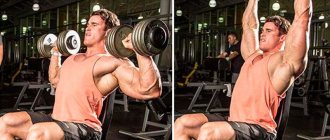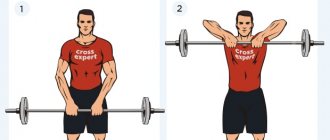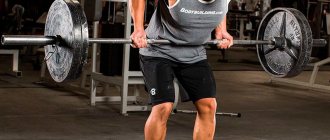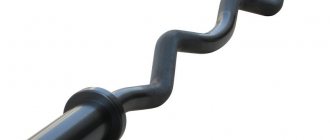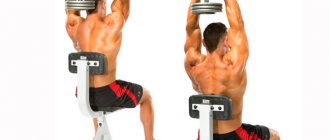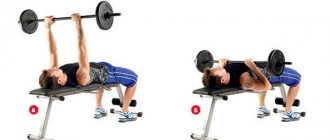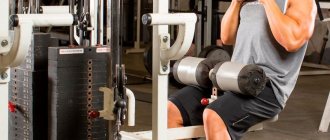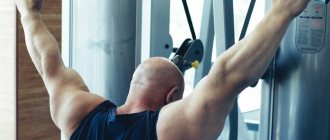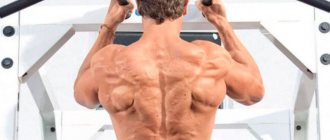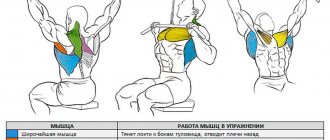The benefits of the exercise and features of its implementation
The incline bench press is performed in several variations. First of all, this concerns the angle of the bench.
Common positions are 30 and 45° tilts:
- It is believed that at 30 degrees the load on the pectorals is evenly distributed over its middle and upper parts. At the same time, the help of the front deltas is moderate
- When the back of the bench is raised to 45 degrees, most of the load is shifted to the upper chest. However, the front deltoids also become more involved in the work, taking on part of the load.
Not as common, but still used is the 70 degree angle press. The shoulders mainly work here, and the role of the pectoral muscles is auxiliary (their upper, supraclavicular part works).
Another characteristic position is grip width . In the classic version, a wide one is used. Usually at the level of the notches that are located along the edges of the fingerboard. As a result, the grip width is 80-85 cm.
The second option was popular in the 60-70s of the last century. Here the press was performed with the widest possible grip. If the length of the arms allowed, the palms almost touched the inside of the barbell coupling.
It was believed that this technique better pumps the outer part of the pectoral muscles. Nowadays this option is rarely used due to the high risk of injury to the shoulder joints.
The third type of grip is narrow (approximately shoulder width). To pump up the pectoral muscles, the elbows are spread to the sides. This way the inner part of the chest is worked out.
If the elbows are pressed against the body throughout the entire movement, most of the load goes into the triceps.
Features of the bench press with a narrow grip
The close-grip bench press is a multi-joint exercise that targets all heads of the triceps brachii muscle. It is considered one of the most effective for building muscle mass in this part of the arm.
This option differs from the classic bench press in several ways. The first is grip width. So, in the classic version of the exercise, the distance between the palms is 55–60 cm. Another difference is the trajectory of the barbell. The weight is raised and lowered strictly vertically.
The close-grip bench press is one of the basic exercises for bodybuilders.
When pressing with a narrow grip, more muscles are involved in the work:
- Triceps upper limb and shoulder;
- Large pectoralis;
- Anterior delta;
- Elbows;
- Latissimus dorsalis;
- Abdominal;
- Trapezoidal.
It is important! If the athlete performs this press correctly, he strengthens other parts of the muscular skeleton.
Benefits of Exercise
Some of the benefits of the close grip bench press include:
- Effective in increasing triceps mass;
- Versatility, since such a load develops maximum mass and strength;
- High results in the classic bench press - this method of lifting the barbell affects not only the triceps, but also the anterior deltoids and chest.
Muscle groups involved during training
The close grip press is a good exercise for women, especially those who don’t move much. Light weights are recommended for them. You should perform at least 12 repetitions per set. Then the load is gradually repeated. There are often concerns that such exercises will provoke excessive relief. But the fears are unfounded. Such training just creates a beautiful shape of the hands.
Common Mistakes
Despite the apparent ease of movement, here, as in other exercises, mistakes are made when performing.
- Bringing your elbows forward, behind the projection of the bar
The chest style of the barbell press at an angle involves the “cross arms” technique. This is when the arms are spread to the sides and the shoulder is perpendicular to the body. That is, the elbows are located under the bar.
This technique is designed to maximize activation of the chest muscle fibers.
Only a slight movement of the elbows forward is allowed to relieve the load on the shoulder joints.
- Incorrect bench angle
It has already been mentioned that the optimal angle of the bench for working out the chest muscles is 30-45 degrees.
You can try 70 degrees. This is more likely not a technical error, but an experiment to determine your own “working” bench inclination.
- Trying to use the same weights as on the flat bench
This is probably the most common mistake.
The angled press is an order of magnitude heavier than the horizontal bench press. Therefore, less working weights are used here. And that's okay.
- Bouncing the barbell off your chest
This mistake is made not only by beginners, but also by experienced gym goers.
By using a chop, you can do more repetitions or lift a heavier barbell. But the movement is performed not only by muscle strength, but also by connecting inertia.
The result is a paradox - the working weights are greater, but the load on the pectoral muscles is less.
- Wrist curl
This simple technical error leads to severe pain in the wrist over time. And this problem is easy to prevent.
From your first incline bench press workouts, pay attention to the position of the barbell in your palms. The bar should be as close to the pads of your thumbs as possible.
In this case, the hand is fixed, and no traumatic load is placed on the wrists.
Bench press on a horizontal bench
Main working muscles:
- Chest muscles
Additional muscles worked:
- Deltoid muscles (anterior bundle)
- Triceps
Initial position:
Lie down on a bench and grab the bar with a grip slightly wider than shoulder-width apart. It doesn't matter how you hold the barbell, open or closed grip. The main thing is that you must maintain complete control over it. The head is pressed against the bench. The shoulder blades are retracted. There is a deflection in the lower back. Feet rest on the floor.
Exercise technique:
- Smoothly, while inhaling, lower the barbell until it touches your lower chest.
- As you exhale, press the barbell up.
During the exercise, make sure that the bar moves only in the vertical plane. The elbows are under the bar. Throughout the entire movement, the shoulder blades remain retracted and the lower back arched. On inhalation - slowly down, on exhalation - powerfully up.
Contraindications
Since the exercise is performed with heavy weights, the risk of injury increases.
The main contraindications for performing bench presses at an angle include:
- Diseases or injuries of the joints - shoulders, elbows and hands
- Injuries and sprains of muscles and ligaments involved in movement
- Heart and vascular diseases and high blood pressure
The barbell press is a heavy strength exercise. For people with heart problems, it is better to use moderate weight, because when lifting the barbell upward, the pressure increases and the load on the heart increases. And the more weight, the stronger it is.
How to replace the bench press with a narrow grip
It's not always possible to go to the gym. Therefore, the question arises: what can replace the exercise, for example, at home?
One of the suitable replacement options is push-ups from the floor or pipe. Place your palms closer to each other.
If you can’t go to the gym, you can replace the exercise with push-ups on a pipe with a narrow grip
The barbell can also be replaced with dumbbells. Instead of a bench, stools placed in a row are suitable.
Anatomical map of active muscles
When performing a barbell press with a narrow position of the arms, the work includes: fascicles of the triceps muscle (medial, lateral, long), pectoral and deltoid muscles (acting as an assistant). In addition, stabilizers are activated, allowing you to maintain balance during movements: shoulder rotators, serratus muscles, wrist flexors. Thus, the triceps receive the greatest load in the process of raising and lowering the barbell. However, the wider the grip on the bar, the less the triceps work and the more the chest muscles work. This is why it is important to maintain a distance between your hands on the barbell when performing the press.
Muscle Atlas
Target, stabilizing, and accessory muscles activated during the close-grip barbell press
Target, stabilizing, and accessory muscles activated during the close-grip barbell press
Cheats
Bodybuilding professionals have special techniques aimed at overcoming problems with heavy weights. By using them correctly you can get additional results.
Cheating consists of helping muscles through third-party actions. In this case, you can push the bar from the chest to overcome the most difficult moment of the entire movement, collecting the fruits of a complete contraction.
However, you need to be an experienced athlete whose skeleton is already strong enough to tolerate such an operation.
In addition, you should not cheat with too large weights. Adrenaline and testosterone in the blood may prevent you from feeling something is wrong.
Often, athletes discovered serious damage to their bones after training.
Muscles involved
Not only the triceps are included in the work, although the main emphasis is on it. The triceps muscle (all 3 heads) is used as a holder. Movement is provided by the pectoral and anterior deltoid muscles. The rear delts, leg muscles, abs and back are auxiliary.
The triceps brachii muscle is responsible for extending the arm at the elbow joint. The pectoralis major – “pushes” the elbows forward and also brings them together. The serratus anterior muscle is necessary for spreading the shoulder blades, and the trapezius muscle is necessary for raising and rotating the shoulder blades. The front delts allow you to move your arm forward and upward.
Tips for getting the most out of this exercise
- Don't pause at the bottom of the movement. The main task in this exercise is to keep the triceps in constant tension. If you put the barbell down and hold this position for a few seconds, then your triceps will relax. And in order to lift the weight from a dead point, you will have to engage the pectoral muscles.
- Movements should be slow and controlled. There is no need to throw the barbell down and then spring it up like a trampoline. First of all, it's not safe. Secondly, such a technique will be of no use for triceps growth.
- Do warm-up approaches before workers. This is a required item. With warm-up approaches you will not only warm up your muscles and ligaments, thereby minimizing the risk of injury. But you will also practice the movement itself, preparing the central nervous system for the movement being performed.
- Try a bench with a negative incline (downward) to increase the range of motion. This technique is used by many professionals in order to work the triceps at the maximum available amplitude. That is, your task is to take a special bench for pressing upside down. All rules regarding execution technique are also relevant for this option. I mean grip, elbow position, drop point, etc. For safety, you can perform this press in a Smith machine.
- Since the exercise is basic, it is better to do it at the beginning of a triceps workout. This rule is true for any multi-joint exercise and this is no exception. Since it is very energy-intensive, it is better to do it while you are full of strength, and then hammer the triceps with isolated exercises.
Here are all the basic points that everyone from beginner to professional should know in order to achieve significant results.
Good luck to everyone in your training!
Verdict
So who wins the race? The answer is simple - the participants reached the finish line at the same time! Depending on your injury susceptibility, equipment availability, and training program, you may be able to use both parallel bars and close-grip bench presses. The variability of the load using maximum working weights will become a real stress for the triceps muscles and will leave any isolation movement far behind. Both exercises are large, multi-joint movements that have practical applications in everyday life and help you make progress in other exercises, such as variations of the bench press and shoulder press. In addition, they will add stability to the shoulder girdle when performing pull-ups and pulling movements.
Try alternating these exercises in your triceps workouts, supplementing them with lat presses or French bench presses. In no time at all, you'll be lifting more weight, not to mention you'll have bigger, more powerful, and defined triceps.
Dips
Parallel bar push-ups are used to pump up the triceps and pectoral muscles, but in this article I will only consider the option for working the triceps muscles. The exercise is performed on parallel bars, with a grip slightly wider than shoulder width. As you lower down, keep your torso vertical and your elbows close to your body. When the angle of the elbow joints is 90° or less (the degree of comfort varies from person to person), begin the upward movement, keeping the torso vertical and contracting the triceps. Repeat as many times as you can.
Pros:
A great compound exercise, parallel bars are a simple and accessible solution because you don't need a bench, barbell or dumbbells. This exercise is a great indicator of arm and shoulder strength and demonstrates true control over your body weight. In addition, push-ups have applications in everyday life and develop assistive strength that will help you perform the bench press and increase joint stability. And by adding a weight belt or holding a dumbbell between your legs, you can easily increase the load.
Minuses:
Push-ups are contraindicated if you have shoulder pain, a pulled or pinched muscle, and/or any problems with your elbow joints. Another common mistake is putting too much weight on the belt, which has a negative impact on the technical aspects, namely reducing the range of motion and reducing results. Finally, since triceps dips require you to maintain as vertical a position as possible, core strength becomes essential for control and stability. If you are missing this important component, it will be quite difficult to perform the exercise correctly.
